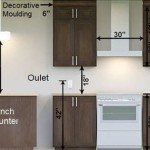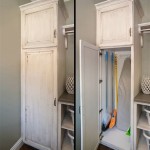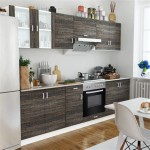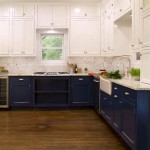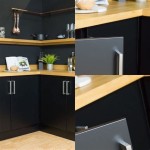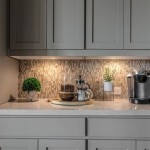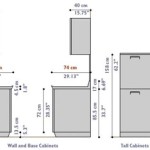Glaze For Painted Kitchen Cabinets: Enhancing Aesthetics and Longevity
Kitchen cabinets are a prominent feature of any kitchen, significantly impacting its overall style and functionality. Painting cabinets offers a cost-effective way to refresh the kitchen's appearance without a complete remodel. Adding a glaze to painted kitchen cabinets can further elevate their visual appeal, providing depth, dimension, and a touch of character. This article explores the purpose, types, application techniques, and considerations for applying glaze to painted kitchen cabinets.
Glazing painted kitchen cabinets involves applying a semi-transparent or opaque coating over the base paint color. This glaze settles into crevices, corners, and details, highlighting the cabinet's texture and architectural features. The result is a nuanced, multi-toned finish that adds visual interest and a sense of age or sophistication.
Purpose of Glaze on Painted Kitchen Cabinets
The primary purpose of glazing is to enhance the aesthetic appeal of painted kitchen cabinets. Glaze achieves this by:
- Accentuation of Details: Glaze highlights the cabinet's design elements, such as raised panels, molding, and trim. The darker glaze settles into these areas, creating contrast and emphasizing their contours, making the cabinet design more pronounced.
- Creation of Depth and Dimension: A glaze adds a layer of visual depth to the cabinets. The variation in color created by the glaze makes the surface appear less flat and more three-dimensional. This effect is particularly desirable in kitchens aiming for a traditional or antique aesthetic.
- Adding Character and Warmth: Glazes can impart a sense of age and character to new cabinets, mimicking the look of antique or distressed furniture. Warmer-toned glazes, such as browns and ambers, can infuse the kitchen with a cozy and inviting atmosphere.
- Protection of Painted Surfaces: While the primary function is aesthetic, some glazes also provide a degree of protection to the underlying paint. They can act as a sealant, helping to resist stains, scratches, and general wear and tear. However, it's essential to note that glaze is not a substitute for a durable topcoat.
Glaze offers homeowners a customized way to achieve a specific look for their kitchen cabinets. Depending on the color of the glaze and the application technique, a wide range of styles can be achieved, from subtle and elegant to bold and dramatic.
Types of Glazes Suitable for Kitchen Cabinets
Several types of glazes are available, each with its own characteristics and application requirements. Choosing the right type of glaze is crucial for achieving the desired aesthetic and ensuring a durable, long-lasting finish.
- Water-Based Glazes: Water-based glazes are popular for their ease of use, low odor, and quick cleanup. They are generally more environmentally friendly than solvent-based glazes. Water-based glazes are suitable for use over water-based paints and are less likely to cause the underlying paint to lift or crack. They typically dry to a softer finish, which may require a protective topcoat for added durability in a high-use kitchen.
- Oil-Based Glazes: Oil-based glazes offer excellent workability and a longer open time, allowing for greater control during application and wiping. They tend to produce a richer, more lustrous finish than water-based glazes. However, oil-based glazes have a stronger odor, require mineral spirits for cleanup, and can be more challenging to apply. They are ideal for creating a more traditional, antique-look glaze.
- Acrylic Glazes: Acrylic glazes combine some of the benefits of both water-based and oil-based glazes. They are water-based for easy cleanup and low odor but offer improved durability and adhesion compared to standard water-based formulas. Acrylic glazes are a versatile option suitable for a variety of applications, including kitchen cabinets.
- Gel Stains: While technically not a glaze, gel stains can be used to achieve a similar effect on painted kitchen cabinets. Gel stains are thicker than traditional stains and sit on the surface rather than penetrating it. This makes them ideal for use over painted surfaces where a subtle color wash is desired. Gel stains are available in a wide range of colors and can be applied and wiped similarly to a glaze.
When selecting a glaze, it is important to consider its compatibility with the type of paint used on the cabinets. Using incompatible products can lead to adhesion problems, cracking, or discoloration.
Application Techniques for Glazing Kitchen Cabinets
Proper application is critical for achieving a professional-looking glazed finish on kitchen cabinets. The specific technique used will depend on the desired effect and the type of glaze being applied.
- Preparation: Prior to applying the glaze, the cabinets should be clean, dry, and free of any imperfections. Lightly sanding the painted surface can improve adhesion and create a smoother surface for the glaze. Applying a primer can also enhance adhesion and ensure a uniform base for the glaze.
- Application: The glaze should be applied evenly using a brush, roller, or rag. Avoid applying the glaze too thickly, as this can make it difficult to control the final appearance. For detailed areas, a small brush or artist's brush can be used to precisely apply the glaze.
- Wiping: After applying the glaze, it is essential to wipe away the excess glaze from the surface. This can be done using a clean, lint-free cloth, a sponge, or even paper towels. The wiping technique will determine the final look of the glaze. Wiping in the direction of the grain can create a more natural, wood-like effect. Using a stippling brush or textured pad can create a more distressed or textured finish.
- Sealing: Once the glaze has dried completely, applying a clear topcoat is often recommended to protect the finish and enhance its durability. A water-based polyurethane or acrylic topcoat is a good choice for water-based glazes, while an oil-based topcoat can be used over oil-based glazes. The topcoat should be applied in thin, even coats, allowing each coat to dry completely before applying the next.
Different wiping techniques can yield various results. Experimenting with different cloths, sponges, and pressures can help achieve the desired effect. For example, using a dry brush after wiping can soften the glaze lines and create a more blended appearance.
Color Considerations for Glaze Application
Choosing the right glaze color is important for complementing the base paint color and enhancing the overall aesthetic of the kitchen cabinets. The color of the glaze can significantly impact the final look of the cabinets, influencing the perceived warmth, depth, and character.
- Contrasting Colors: Using a glaze that contrasts with the base paint color can create a more dramatic and eye-catching effect. For example, a dark brown or black glaze over a light cream or white cabinet can highlight the details and add a sense of depth. However, it is important to choose contrasting colors that work well together and avoid combinations that clash or look too harsh.
- Complementary Colors: A glaze that complements the base paint color can create a more subtle and harmonious look. For example, a warm brown or amber glaze over a beige or tan cabinet can enhance the warmth and richness of the color. Complementary colors create a cohesive and balanced aesthetic, suitable for kitchens aiming for a more refined and elegant style.
- Metallic Glazes: Metallic glazes, such as gold, silver, or bronze, can add a touch of glamour and sophistication to kitchen cabinets. These glazes are best used sparingly and in conjunction with a neutral base paint color. Metallic glazes can be particularly effective for highlighting intricate details or creating a focal point in the kitchen.
- Neutral Glazes: Neutral glazes, such as gray, taupe, or off-white, can be used to soften the base paint color and create a more muted and understated look. These glazes are versatile and can be used with a wide range of base paint colors. They are ideal for kitchens aiming for a modern or minimalist aesthetic.
When selecting a glaze color, consider the overall color scheme of the kitchen and the desired aesthetic. It is also helpful to test the glaze color on a sample board before applying it to the cabinets to ensure that it achieves the desired effect.
Troubleshooting Common Glazing Issues
While glazing painted kitchen cabinets can be a rewarding project, it is not without its challenges. Understanding common issues and how to address them can help ensure a successful outcome.
- Uneven Glaze Application: Uneven glaze application can result in a patchy or inconsistent finish. To avoid this, apply the glaze evenly and work quickly to wipe away excess glaze before it dries. If the glaze is drying too quickly, use a retarder to extend the open time.
- Streaking or Brush Marks: Streaking or brush marks can occur if the glaze is not properly applied or wiped. To minimize streaking, use a high-quality brush or applicator and apply the glaze in smooth, even strokes. When wiping, use a clean, lint-free cloth and apply consistent pressure.
- Lifting or Cracking: Glaze can sometimes cause the underlying paint to lift or crack. This is more common when using incompatible products or applying the glaze too thickly. To prevent lifting or cracking, use compatible glazes and paints and apply the glaze in thin, even coats.
- Color Bleeding: Color bleeding can occur if the glaze is not properly sealed. This can result in the glaze color seeping into the surrounding areas. To prevent color bleeding, apply a clear topcoat over the glaze to seal it and protect it from moisture and stains.
If any issues arise during the glazing process, it is important to address them promptly. In some cases, it may be necessary to remove the glaze and start over. Patience and attention to detail are key to achieving a flawless glazed finish.
Applying a glaze to painted kitchen cabinets is a transformative process that can enhance their beauty and add a touch of personalized style. Understanding the purpose of glazing, selecting the right type of glaze, mastering the application techniques, considering color choices, and troubleshooting common issues are all important factors in achieving a professional-looking result. With careful planning and execution, homeowners can create stunning kitchen cabinets that will be admired for years to come.

How To Glaze Kitchen Cabinets Diyer S Guide Bob Vila

How To Glaze Kitchen Cabinets

How To Glaze Cabinets At Home With The Barkers

Rescuing And Reviving A Glazed Distressed Kitchen Bella Tucker

How To Glaze Kitchen Cabinets Diyer S Guide Bob Vila

3 Great Reasons To Glaze Your Kitchen Cabinets

Porchswings N Honeysuckle Paint And Glaze Cabinet Tutorial Kitchen Cabinets Makeover Renovation Glazed

How To Glaze Cabinets At Home With The Barkers

Painted Furniture Ideas 3 Steps To Glaze Cabinets Correctly

3 Steps To Glaze Cabinets Correctly Painted Furniture Ideas Glazed Kitchen Chalk Paint Distressed
Related Posts


